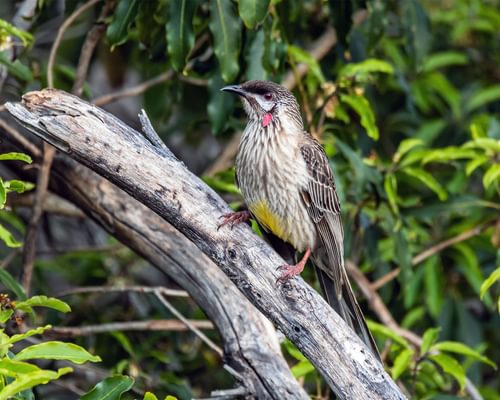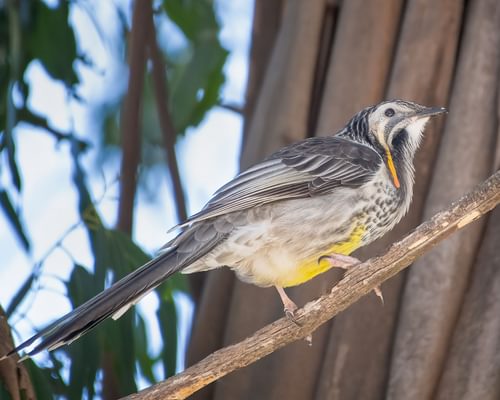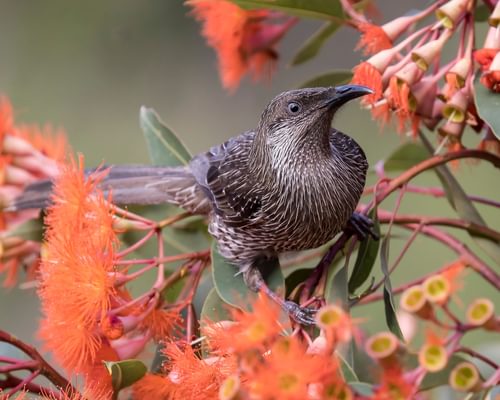Western Wattlebird
Least ConcernAnthochaera lunulata
Visual Identification
Appearance
The Western Wattlebird is a large honeyeater with distinctive plumage. Its upperparts are predominantly brown with white streaks, while the underparts are greyish-white, brown with white chevron-like markings. Despite its name, it lacks the distinctive wattles of its relatives.
Both sexes look similar, with a long, curved bill and a relatively long tail. Juveniles resemble adults but have less prominent wattles and duller overall colouration.
Size
Length
33cm to 38cm
Wingspan
45cm to 50cm
Weight
100g to 140g
Colours
Males and females have similar plumage
Primary Colour
Brown Grey
Secondary Colour
White
Beak Colour
Black
Leg Colour
Grey
Habitat and Distribution
Habitats
Woodland
Garden
Wetland
Coastal
Urban
Farmland
Grassland
Desert
Tundra
Rainforest
Mountain
Savanna
Distribution
Western Wattlebirds are endemic to southwestern Australia, ranging from Carnarvon to east of Esperance. They inhabit eucalyptus woodlands, coastal heathlands, and urban areas with native vegetation.
While primarily sedentary, some local movements occur in response to flowering patterns. In Australia, they are common in Perth and other urban areas where suitable native plants are present.
Elevation Range
Up to 1,000 meters
Climate zones
Temperate, Mediterranean
Distribution Map
This map gives you a rough idea of where you might spot a Western Wattlebird. The coloured areas show countries where these birds have been seen.
A few things to keep in mind:
- Birds might not be everywhere in the coloured areas, for example, they may be present around the coast of that country
- Where birds live can change with seasons and available food
- This map is quite simple - it doesn't show exact locations
We're working on making our maps even better! Soon, we hope to show you:
- More detailed maps for bigger countries, including state and region
- How birds move around during different seasons
Distribution by Region
Behaviour and Ecology
Bird Attributes
This feature is in beta. We'd love your feedback to improve it!
Share your thoughtsBird Attributes Explained
Our bird attributes system rates various aspects of a bird's capabilities on a scale of 0-100, based on data from field observations, scientific studies, and expert knowledge.
Attribute Categories:
- Agility: Manoeuvrability, speed, and grace in flight or movement.
- Strength: Physical power, often correlating with size and hunting abilities.
- Adaptability: Ability to thrive in various environments or changing conditions.
- Aggressiveness: Territorial behaviour and assertiveness, particularly during breeding seasons.
- Endurance: Stamina, often seen in migration patterns or foraging behaviours.
Understanding the Ratings:
- 0-20: Very Low
- 21-40: Low
- 41-60: Average
- 61-80: High
- 81-100: Very High
Remember, these attributes are relative to other bird species and don't necessarily indicate superiority.
Hover over the icon next to each attribute for more information.
Tap the icon next to each attribute for more information.
Agility
Reflects the bird's manoeuvrability, speed, and grace in flight or movement.
The Western Wattlebird demonstrates high agility with its ability to move swiftly through the canopy, perform direct flight, and hang upside down to reach nectar. Its adept manoeuvring suggests excellent aerial prowess.
Strength
Indicates the bird's physical power, often correlating with size and hunting abilities.
As a large honeyeater, the Western Wattlebird possesses moderate strength. Its size (33-38 cm length, 100-140 g weight) and ability to defend territories indicate decent physical capability, though not exceptional among birds.
Adaptability
Represents the bird's ability to thrive in various environments or changing conditions.
The species shows good adaptability by thriving in various habitats, including eucalyptus woodlands, coastal heathlands, and urban areas with native vegetation. Its ability to adjust to flowering patterns and urban environments demonstrates considerable adaptiveness.
Aggressiveness
Measures the bird's territorial behaviour and assertiveness, particularly during breeding seasons.
Western Wattlebirds are notably aggressive, particularly in territorial defence. They're known for chasing away other birds from flowering plants and vigorously protecting their breeding territories, indicating a high level of aggression.
Endurance
Reflects the bird's stamina, often seen in migration patterns or foraging behaviours.
The bird's ability to consume up to half its body weight in nectar daily and engage in energetic territorial defence suggests good endurance. However, as a primarily sedentary species with some local movements, its long-distance endurance may be limited compared to migratory birds.
Diet
The Western Wattlebird primarily feeds on nectar from native flowers, particularly those of eucalyptus and banksia. They supplement their diet with insects, especially during breeding season.
These birds have been observed using their brush-tipped tongues to extract nectar efficiently from deep flowers.
Behaviour
Western Wattlebirds are known for their aggressive territorial behaviour, often chasing away other birds from flowering plants. They move through the canopy with an agile, direct flight and can be seen hanging upside down to reach the nectar.
These birds are typically solitary or found in pairs, becoming more social during the non-breeding season.
Vocalisation
The Western Wattlebird's call is highly distinctive and often described as a harsh, coughing sound. It's frequently rendered as a loud 'tok-tok' or 'chock'.
During the breeding season, males may produce a series of guttural notes that sound like 'kuk-kuk-kuk-kuk', especially when defending territory.
Nesting & Breeding
The breeding season for Western Wattlebirds typically spans from July to January. Pairs form monogamous bonds and defend territories aggressively during this period.
Nests are cup-shaped structures made of twigs, bark, and grass, often lined with soft materials. They are usually placed high in the fork of a tree or tall shrub. The female lays 2-3 pale pink eggs with reddish-brown spots.
Incubation lasts about 16 days, primarily carried out by the female. Both parents feed the chicks, which fledge after approximately 20 days but continue to be fed by adults for several weeks after leaving the nest.
Lifespan
The Western Wattlebird typically lives for 5 to 11 years, with a maximum recorded lifespan of 11.5 years.
Like all birds, lifespan can be affected by factors including predation, habitat quality, disease, and access to food sources.
Conservation and Status
Global Conservation Status
While the Western Wattlebird is currently listed as Least Concern, it faces threats from habitat loss due to urban development and agriculture.
Conservation efforts focus on preserving native vegetation in urban and coastal areas, which are crucial for this species' survival.
Population Data
Global Population Estimate
Not quantified
Birdwatching Tips
- Look for Western Wattlebirds in flowering eucalyptus trees and banksias
- Listen for their distinctive harsh, coughing call
- Observe their aggressive behaviour towards other birds
- In urban areas, check parks and gardens with native plantings
Additional Information
Quick Facts
Other names:
Lunulated Wattlebird
Family:
MeliphagidaePredators
Main predators of Western Wattlebirds include raptors such as goshawks and falcons, as well as introduced mammals like cats and foxes in urban and suburban areas.
Did You Know?
- Western Wattlebirds can consume up to half their body weight in nectar each day.
- These birds play a crucial role in pollinating native Australian plants.
Was this bird profile helpful?
Your feedback helps us improve our content
Thanks for your feedback!
Your input helps us improve our content.
Community Experience
Community Ratings
No ratings yet - be the first to rate this bird!
Latest Community Reviews
No reviews yet
Sign in to be the first to review
Community Reviews
Create Your Free Account Welcome Back!
Join our community to rate birds and share your experiences. Creating an account is completely free and only takes a minute. Sign in to your account to rate birds and share your experiences with our community.
Your information is secure and will never be shared.
By creating an account, you agree to our Privacy Policy.
Similar Birds
References
- 2 3
website: BirdLife International. 2016. Anthochaera lunulata. The IUCN Red List of Threatened Species 2016: e.T22704454A93969512.
View source - 1
website: ABBBS - Australian Bird and Bat Banding Scheme
View source


